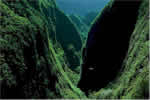

 |
The Seventh International Conference on Systems ICONS 2012 February 29 - March 5, 2012 - Saint Gilles, Reunion Island |
| Tutorials |
T1. Robust Computation in Engineering, Geometry and Duality
by Prof. Dr. Vaclav Skala, University of West Bohemia - Plzen & VSB-Technical University Ostrava, Czech Republic
T2. Chaotic Neural Network for Biometric Pattern Recognition
by Prof. Dr. Marina Gavrilova, University of Calgary, Canada
DETAILS
T1. Robust Computation in Engineering, Geometry and Duality
by Prof. Dr. Vaclav Skala, University of West Bohemia - Plzen & VSB-Technical University Ostrava, Czech Republic
Development of new algorithms is a crucial part not only in research, but it is needed in Engineering applications, namely in all computational fields, Computer Graphics, Visualization and Computer Vision fields.
Understanding of projective geometry and the principle of duality enable to understand the substance of the solved problem as the problem can be transformed to a dual space, where the solution is simple and/or helps to develop new algorithms.
Projective geometry notation and use can be used in computational problems and in many cases helps to speed up computation. Especially if the matrix-vector architecture like GPU is used, the reformulation of the problem using projective notation increases the speed of computation.
The principles will be demonstrated on simple examples.
Examples of computational problems, disasters caused by numerical computations will be presented
· Typical engineering and geometrical problems
· Euclidean and projective spaces, transformations, properties
· Duality (linear), property of dual transformation, dual problems
· Algorithm complexity – simple geometrical examples – and dual problems
· How dual formulation can influence development of a new method, algorithm
· Robustness and influence to algorithm design
· Typical examples how projective/dual formulation can speed up computation
· How projective formulation supports algorithms for GPU architecture
· Typical examples of geometrical problems, their projective reformulation leading to significant speed up and in some cases to reconsideration leading to lower algorithm complexity.
References:
· Skala,V.: Geometric Computation, Duality and Projective Space, ICGG 2010 conference, Kyoto, Japan, 2010
· Skala,V.: Barycentric Coordinates Computation in Homogeneous Coordinates, Computers & Graphics, Elsevier, ISSN 0097-8493, Vol. 32, No.1, pp.120-127, 2008
· Skala,V.: Intersection Computation in Projective Space using Homogeneous Coordinates, Int.Journal on Image and Graphics, DOI No: 10.1142/S021946780800326X, ISSN 0219-4678, Vol.8, No.4, pp.615-628, 2008
· Skala,V.: Length, Area and Volume Computation in Homogeneous Coordinates, International Journal of Image and Graphics, Vol.6., No.4, pp.625-639, ISSN 0219-4678, 2006
· Duality and Intersection Computation in Projective Space with GPU support, Applied Mathematics, Simulation and Modeling - ASM 2010 conference, NAUN, Corfu, Greece, pp.66-71, ISSN 1792-4332, ISBN 978-960-474-210-3, 2010
· Skala,V:Duality and Intersection Computation in Projective Space with GPU Support, WSEAS Trans.on Mathematics, Vol.9.No.6.pp.407-416, 2010
· Skala,V.: Intersection Computation in Projective Space using Homogeneous Coordinates, Int.Journal on Image and Graphics, DOI No: 10.1142/S021946780800326X, ISSN 0219-4678, Vol.8, No.4, pp. 615-628, 2008
Recently given tutorials
· Skala,V.: Mathematical Foundations for Computer Graphics and Virtual Reality, Tutorial Intuition 2008 conference, Torino, Italy, 2008
· Skala,V.: Mathematical Foundations for Computer Graphics and Computer Vision, Tutorial CGI 2008 conference, Istanbul, Turkey, 2008
· Skala,V.: Mathematical Foundations for Computer Graphics and Vision and Computations in Projective Spaces, Tutorial 3DTV conference, 2007
T2. Chaotic Neural Network for Biometric Pattern Recognition
by Prof. Dr. Marina Gavrilova, University of Calgary, Canada
The area of biometric, without a doubt, is one of the most dynamic areas of interest, which recently has displayed a gamut of broader links to other fields of sciences. Among those are visualization, robotics, multidimensional data analysis, artificial intelligence, learning, data fusion and data synthesis. The topic of this tutorial is state-of-the-art in multi-modal data fusion, fuzzy logic and neural networks and its recent connections to advanced biometric research. The area of biometric originates from biometry – a field of biology that deals with human characteristics. Some early uses of biometrics are attributed to Middle East merchants stamping their clay pots with the imprint of their thumb. Early classification methods were later developed in criminology, specifically in Scotland Yard, to classify criminals based on “soft” (hair color, eyes color, height, weight) as well as “hard” biometric (fingerprint, handprint, face image). The rapid development of massive databases and image processing techniques has led over the past ten years to the significant spur in biometric research and relevant industrial product development. Typical applications include banking, border control, law enforcement, e-commerce and restricted access to certain resources.
Over the recent decade, the variety of issues related to biometric system performance and analysis has been addressed in literature. The high number of biometric samples, data variability, error-rates, data acquisition device performance, dealing with noise, and the need for improved precision and reduced error rates has influenced an increased attention to this area. However, even with the most computationally sophisticated techniques, and advanced algorithms, no single biometric can authenticate a person with hundred percent confidence in results. Thus, a new approach based on multi-modal biometric system has recently emerged as a more reliable way of person identification and authentication.
The advantages of multimodal systems stem from the fact that there are multiple sources of information. The most prominent implications of this are increased security, fewer enrollment problems and enhanced accuracy. All multimodal biometric systems need a fusion module that takes individual data and combines it in order to obtain the authentication result: impostor or genuine user.
This tutorial reviews current trends related to information fusion in multimodal biometric system and provides foundations and background on neural networks, specifically chaotic neural networks, as a learning tool to improve system performance. Experimental data for facial, fingerprint and multi-modal biometrics is provided to illustrate the concepts. Applications to other domains, such as EEG emotion recognition and avatar recognition will also be discussed.